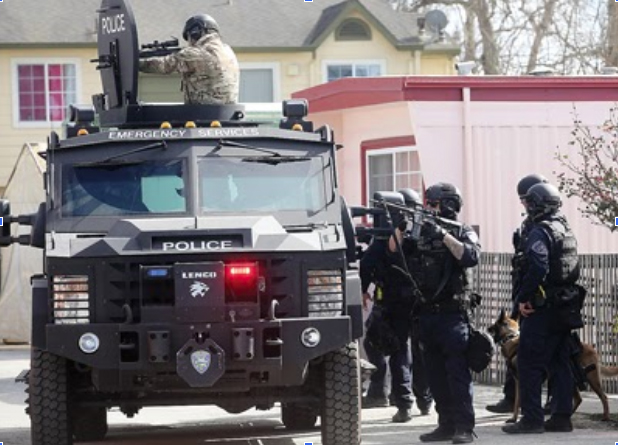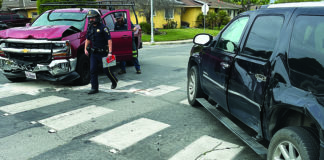
WATSONVILLE—Watsonville Police Department has several military-grade weapons that it says it only uses in extraordinary circumstances.
That armory includes nearly two dozen high-powered rifles, a few shotguns, thousands of rounds of ammunition and dozens of less-lethal and “crowd control” weapons such as flashbangs, rubber grenades and a grenade launcher and chemical agents such as tear gas.
Because of a new state law, WPD is now required to publicly disclose this list of armaments, draft a policy of how and when these weapons will be used and report to the Watsonville City Council whenever it does deploy them.
Assembly Bill 481, which became law at the beginning of the year, also requires police and sheriff’s offices to get approval from their council or board to purchase military-grade equipment and that they go before the elected leaders for an annual review of their policy.
The council approved WPD’s inaugural policy at Tuesday night’s meeting, and will have a second reading on the issue at an upcoming meeting for final approval.
The elected leaders approved the policy 6-1, with councilmember Vanessa Quiroz-Carter casting the lone dissenting vote.
Quiroz-Carter voiced many of the same concerns about the policy that about two dozen people who spoke during public comment did. Her top concern was that the language around what constituted the use of the weapons was too open-ended.
She proposed changing the ordinance to more succinctly spell out when the weapons can be used, and when the department can call in “mutual aid” from a neighboring agency that has military-grade weapons that WPD does not.
City Attorney Samantha Zutler told Quiroz-Carter that the changes might make the ordinance “cumbersome” and that she would have to work with WPD on the language.
Mayor Ari Parker said that Quiroz-Carter could work with Zutler and WPD on proposed changes to the ordinance that would be presented to the council at a future meeting.
“That is certainly something they can put in there,” Parker said. “I’m sure, just like anything, there will be an evolution of this (ordinance) as it continues forward.”
A majority of the council said that these weapons were “tools” needed for WPD to do its job. Also included in the department’s list is a Throwbot, or a remote-controlled reconnaissance robot, and a device used to breach entryways.
They also said that many of the department’s military-grade weapons were purchased several years ago, and that this ordinance gives the community oversight over WPD’s purchases going forward.
Members of the public said that WPD’s policy did not capture the essence of AB481, which, at its core, was a way for local governments to not only increase transparency and accountability within their police departments but also demilitarize them.
“Please question how you see these military weapons positively impacting the community,” said Karina Moreno, a coordinator with MILPA.
People also said the council should direct WPD to get rid of many of its chemical agents and less-lethal weapons that could be used against protests.
“This is basically a laundry list of how to put down protests, and if you look at why protests are happening across the country, it’s because of abuse by (police),” said Travis Walker, a local history teacher. “By allowing them to buy those things, you are arming them with the equipment they will use to suppress people who try to speak out against their abuses. These are not used to protect civil liberties. They are used to take them away.”
That item came about two hours after WPD Assistant Chief Tom Sims gave an update about the state of crime in Watsonville.
Sims laid out about a dozen high-profile violent crimes that have occurred over the past few months and said that the department is projecting a rise in violent crimes this year, as compared to the previous four years.
When asked by the council why the department is projecting that crime is on the rise, Sims said he didn’t have an answer.
“Sometimes there is no rhyme or reason and that’s hard for people to accept because we want to point a finger at something,” Sims said. “I will say this, historically this town has had years of extreme violence, and we’ve been fortunate over the last five or six years where we haven’t seen a lot [of violent crimes] relative to and compared to years before.”
In highlighting what the department is doing to address the projected rise in crime, Sims said WPD recently hired a community engagement coordinator and is developing a team with local service providers to give support to families who have been affected by violent crime. Sims also said that the city’s Parks and Community Services department and the Police Activities League are expanding their services.
In addition, officers are also conducting “proactive and investigative work.”
“You can make a case that arresting certain criminals can influence the crime rate,” Sims said. “For example, if we arrest a burglar, not only do we solve 20 burglaries but if that person is incarcerated, we’ve prevented future crimes from occurring.”
Sims said that because of recent “staffing issues” WPD is moving officers from investigations and special operations to patrol.













